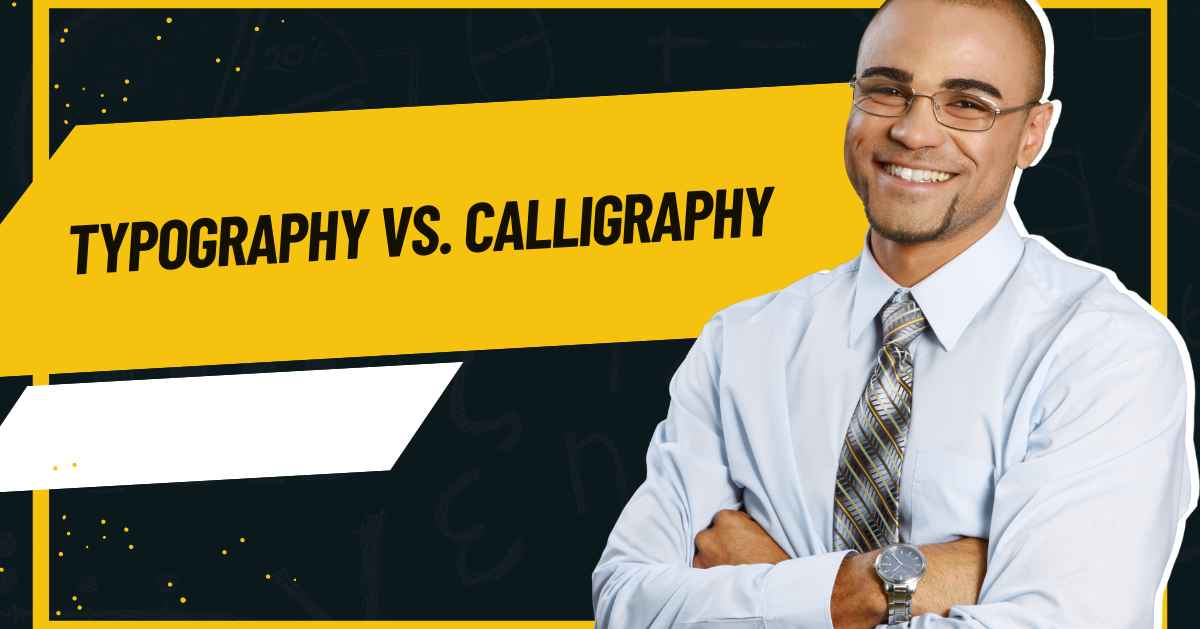Typography vs. Calligraphy: Understanding the Difference

Typography and calligraphy might seem like the same thing to most people, but for designers, there’s a small but essential difference between them. Knowing this difference matters if you want your designs to turn out great. When design firms understand these differences, they can choose the right one for their needs. If your design company is unsure about the distinction, you’ve come to the right place.
Typography and Calligraphy are both forms of visual communication involving creating and arranging written or printed letters and characters, but they differ in their techniques and purposes.
Typography: Typography refers to the art and technique of arranging type to make written language legible, readable, and visually appealing. It involves selecting fonts, adjusting spacing, and placing text to create a coherent and aesthetically pleasing design. Typography is primarily used in graphic design, publishing, advertising, and digital media. It is typically created digitally using software programs and can be easily replicated and modified.
Calligraphy: On the other hand, is the art of beautiful handwriting. It involves the skilled and artistic hand-lettering of characters using various tools, such as pens, brushes, or other writing instruments. Calligraphy focuses on the visual expression of individual letters and often emphasizes the written text’s form, rhythm, and flow. It is used for decorative purposes, such as wedding invitations, certificates, manuscripts, and artistic expression. Unlike typography, calligraphy is usually done by hand and allows for greater personalization and artistic expression in each piece.
Why It Matters:
Understanding the difference between typography and calligraphy is essential, especially for designers. Knowing when to use each can make a big difference in how a text looks and feels. Typography might be better for everyday use, like reading articles or typing emails. On the other hand, calligraphy adds a special touch to essential events or fancy projects.
1. Typography vs. Calligraphy Basics: Typography is when you type on a computer, and Calligraphy is when you write with a special pen on paper. So, they’re quite different.
2. Different Strokes for Different Folks: Calligraphy only allows for single strokes, meaning you can’t make letters with double lines. However, with typography, you can easily create those double-stroke letters using digital fonts.
3. Consistency vs. Creativity: Typography has set fonts, so the letters look exactly the same every time you use the same font. Each letter can look slightly different in calligraphy, giving designers more freedom to play with different styles.
4. Moving Words: Typography is great for videos because you can move the text around, like in animated videos. Calligraphy doesn’t work as well for this because it’s hard to make handwritten text move smoothly.
5. Writing vs. Choosing: In Calligraphy, you write the letters yourself, while in Typography, you pick from pre-designed letters. This means there can be slight differences in how letters look in Calligraphy, but Typography gives more consistent results.
6. Limits and Freedom: Typography has limits; you can’t easily change font styles like in Calligraphy, where you can create your styles.
7. Creativity Rules: In Typography, you’re stuck with the same pattern for each letter, but in Calligraphy, you can get creative and make each letter unique to fit your project.
8. Time Matters: Typography is much faster because machines do most of the work, while Calligraphy requires you to write each letter by hand, which takes much more time.
9. Digital Dominance: With everything moving to digital, Typography is becoming more popular because it’s easier to work with. Even though Calligraphy can be turned into digital art, it’s a complicated process and takes time.
So, in the battle between Typography and Calligraphy, Typography seems to be winning because it’s faster, more consistent, and easier to work within our digital world.
The Key Differences:
So, what’s the big difference between typography and calligraphy? It all comes down to how the letters are created:
- Typography is about arranging pre-designed letters, often using digital tools.
- Calligraphy involves decoratively hand-writing each letter, often using traditional tools like pens and brushes.
How Professional Typography Videos Benefit Design Firms
It’s clear that Typography, a newer art than Calligraphy, is still unfamiliar territory for many design firms. Even talented designers may struggle to make the most of Typography. This is where professional Typography Video Services come in to save the day.
By hiring these services, companies gain several advantages:
- Tailored Designs: Typography experts create designs that perfectly match the company’s values and vision.
- Understanding Business Needs: They take time to understand the company’s requirements and the mindset of its audience, ensuring the videos resonate with consumers.
- Expert Animation: Many Typography service providers have skilled animators who craft engaging videos using kinetic Typography.
- Skill Enhancement: They offer valuable advice to the client’s designers, helping them improve their Typography skills for future projects.
[Also Read: Top Digital Education Tools for Teachers and Students]
Conclusion
Understanding the difference between Typography and Calligraphy is crucial for designers. While Typography offers consistency and speed, Calligraphy allows for creativity and personalization. Both have strengths, but knowing when to use each can greatly enhance design outcomes in various projects.






